Auction Round 3 Yields $9.2 Billion
WASHINGTON—Bids in round three of the TV spectrum forward auction reached $9.7 billion, resulting in $9.2 billion in proceeds once discounts are subtracted. Thus concluded day two of the Federal Communication Commission’s TV spectrum forward auction.
The results were posted on the auction reporting system website Wednesday, Aug. 17, after 4 p.m. ET, when round three concluded.
The system indicated that auction proceeds after round three totaled $9.7 billion, or $9.2 billion after discounts. Bids are discounted 15 or 25 percent for rural providers and smaller business entities, with a collective cap of $10 million. (Correction: The rural service provider bidding credit is 15 percent and capped at $10 million, not the collective discounts.)
The commission ultimately needs to raise around $88 billion to close the auction at its current clearing target of 126 MHz, or else the process must be repeated at a lower clearing target. It also must reach a threshold of competitive pricing of around $1.25 per MHz/population, on average, across the top 40 partial economic areas out of a total of 416 across the country. That equates to nearly $16 billion.
Bidding in the forward auction commenced Tuesday, Aug. 16, with the first round yielding $8.49 billion in bids, or “22 percent less than the total possible demand as set by the FCC’s opening prices,” according to Wells Fargo analysts. The commission established its minimum opening bid prices in June.
The second round took place Wednesday morning and brought in $9.04 billion, an increase of 6 percent over the first round. This “wasn’t particularly surprising,” the analysts said, given that asking price for spectrum blocks is raised 5 percent between rounds where demand exceeds supply. In many cases, it does not, the analysts noted.
Of 4,048 blocks of spectrum available across the country, “forward auction participants have expressed demand for 2,047 blocks of spectrum, up slightly from the 2,041 blocks requested in round one,” they wrote Wednesday after round two.
Bidding rounds will continue in the forward auction for an unspecified amount of time—“so long as demand outpaces supply,” the FCC’s Incentive Auction Task Force Chair, Gary Epstein has said. Should demand fail to cover the $86.4 billion pledged for TV spectrum in the reverse auction—plus another $2 billion to move broadcasters and pay for the auction—then the reverse auction will be repeated at a lower clearing target.
The clearing target for this initial stage of the incentive auction was 126 MHz, with 26 MHz set aside as buffer zones between spectrum usage types. Therefore, the commission must raise around $88 billion from 100 MHz of paired spectrum, or an estimated $2.76 per MHz/pop, the Wells Fargo team said Wednesday. “Paired” spectrum refers to blocks evenly divided into pairs for wireless uplink and downlink transmissions.
In turn, $2.76 MHz/pop is what wireless providers paid, on average, for paired spectrum in their most recent auction, AWS-3, which concluded in January. AWS-3 brought in $45 billion for 50 MHz of paired and 15 MHz of unpaired spectrum at 1.6 and 1.7 GHz, Telecoms reported. The total average MHz/pop price across both was $2.21, according to AGL. AWS-3 went for 341 rounds over 77 days.
The commission determined this first stage clearing target based on the amount of spectrum offered up by broadcasters in the reverse auction. In it’s June, 2014, auction Report and Order, the commission laid out a number of potential band plans on p. 453 that accommodated 11 clearing targets between 144 and 42 MHz. The next lowest clearing target after 126 MHz would be 114 MHz.
Round 4 of the RV spectrum incentive forward auction commences Thursday, Aug. 18 at 10 a.m. ET.
The professional video industry's #1 source for news, trends and product and tech information. Sign up below.
